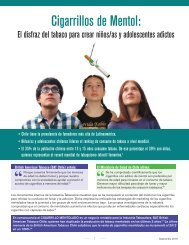Public health successes and missed opportunities
Public-health-successes-and-missed-opportunities-alcohol-mortality-19902014
Public-health-successes-and-missed-opportunities-alcohol-mortality-19902014
You also want an ePaper? Increase the reach of your titles
YUMPU automatically turns print PDFs into web optimized ePapers that Google loves.
CONCLUSION: THE NEED FOR AN ALCOHOL POLICY<br />
Even though alcohol consumption in Europe dates back a long time, the past decades have shown that, despite historical<br />
traditions, modern drinking patterns can change quickly <strong>and</strong> sustainably. The decrease in alcohol consumption in the<br />
traditional wine-producing <strong>and</strong> wine-drinking countries of the Mediterranean region over the past 40 years or so may serve<br />
as an illustration of this point (1,61–63,197). It has been shown that this decrease in consumption in the Mediterranean<br />
countries resulted in a large reduction in alcohol-attributable mortality, which had marked effects on life expectancy<br />
(141). A second example of changing drinking patterns <strong>and</strong> resulting mortality are the Russian experiences following the<br />
Gorbachev-era reform, as well as more recent examples (53,57,169,170).<br />
Some of the changes in drinking patterns <strong>and</strong> subsequent harm reflect fundamental changes in the nature of society.<br />
For example, with shifts away from agriculture in most European economies, the widespread tradition of drinking at<br />
lunchtime is inconsistent with the dem<strong>and</strong>s of the twenty-first century modern economy (for some empirical evidence,<br />
see (198)). Other changes were caused or enforced by alcohol policies.<br />
Certainly, effective (10,199,200) <strong>and</strong> cost-effective policies (201–203) are available to further minimize the burden of<br />
alcohol consumption in European societies. However, even though such policies have been proposed for many years<br />
(204,205) as well as various European action plans (see (9) for the last iteration), relatively little has changed in the<br />
Region, <strong>and</strong> the age-st<strong>and</strong>ardized alcohol-attributable mortality rate for major chronic <strong>and</strong> acute causes of death for the<br />
WHO European Region in 2014 was even higher than 25 years ago. There have been public <strong>health</strong> <strong>successes</strong> in countries,<br />
as shown above, <strong>and</strong> these countries could be used as benchmarks, but there have also been drastic public <strong>health</strong><br />
failures, <strong>and</strong> the overall picture certainly cannot be called a public <strong>health</strong> success. Moreover, as recent examples have<br />
shown, getting alcohol policies wrong may also impact dramatically on the disease burden (156).<br />
In order to initiate policies, up-to-date epidemiological data are needed, integrated into a monitoring <strong>and</strong> surveillance<br />
system (171,172). Time is of the essence here, <strong>and</strong> if relevant data are available to decision-makers within a short<br />
period of one or maximum two years, they will serve the purpose much better (206). This report hopes to stimulate the<br />
establishment of monitoring <strong>and</strong> surveillance systems at the national level, which routinely yield relevant data on the<br />
harmful use of alcohol <strong>and</strong> attributable harm in a relevant way for decision-makers (<strong>and</strong> this can be done with the NCD<br />
monitoring framework (13,207)), but should additionally include liver cirrhosis <strong>and</strong> injury burden.<br />
So what would be the policy conclusions from this report, <strong>and</strong> epidemiological findings on alcohol for Europe in general?<br />
First <strong>and</strong> foremost, it must be stated that overall alcohol consumption is clearly too high in Europe, resulting in considerable<br />
harm. Ideally, assuming that alcohol consumption will persist in Europe, those who choose to drink should limit their<br />
consumption to under 20 g/day (68,208), corresponding to a yearly consumption of 11.6 litres of pure alcohol. However,<br />
this upper threshold for drinking is lower than the current mean drinking level among drinkers in Europe both for men (19.4<br />
litres pure alcohol) <strong>and</strong> for women (12.9 litres pure alcohol). The question is how to shift the current drinking level to one<br />
that would incur the least harm.<br />
Drinking guidelines have become popular in recent years (see recent efforts in Australia, Canada, the United Kingdom <strong>and</strong><br />
the EU (209–212)) as they conform to the modern ideal of a consumer society, with well-informed consumers putatively<br />
adjusting their behaviour based on advice from governmental, research <strong>and</strong> professional sources (213). However, their<br />
effectiveness in changing actual drinking habits is questionable (214,215). Nevertheless, the development of guidelines<br />
reflecting best evidence provides an important reference point for engaging with policy-makers in developing more<br />
directly effective approaches to reducing consumption.<br />
On the other h<strong>and</strong>, the known cost-effective policy options as outlined by the “best buys” in the WHO NCD framework<br />
((13,216), see also footnote 2), i.e. reduction in availability, increase in taxation, <strong>and</strong> ban on marketing <strong>and</strong> advertising,<br />
have not been overly popular with governments, <strong>and</strong> there are no signs that this trend will stop. 20 How could epidemiology<br />
20<br />
There is surprisingly little research on how the “best buys” of availability <strong>and</strong> taxation need to be shaped in light of different environments, as characterized<br />
by the level <strong>and</strong> availability of unrecorded alcohol in different countries (see (217) for a discussion about African countries; <strong>and</strong> (218) for an example of a failed<br />
taxation increase because unrecorded consumption was too important), but such research would be especially necessary for countries in the WHO European<br />
Region, where unrecorded consumption is very common <strong>and</strong> there are huge price differentials.<br />
60




